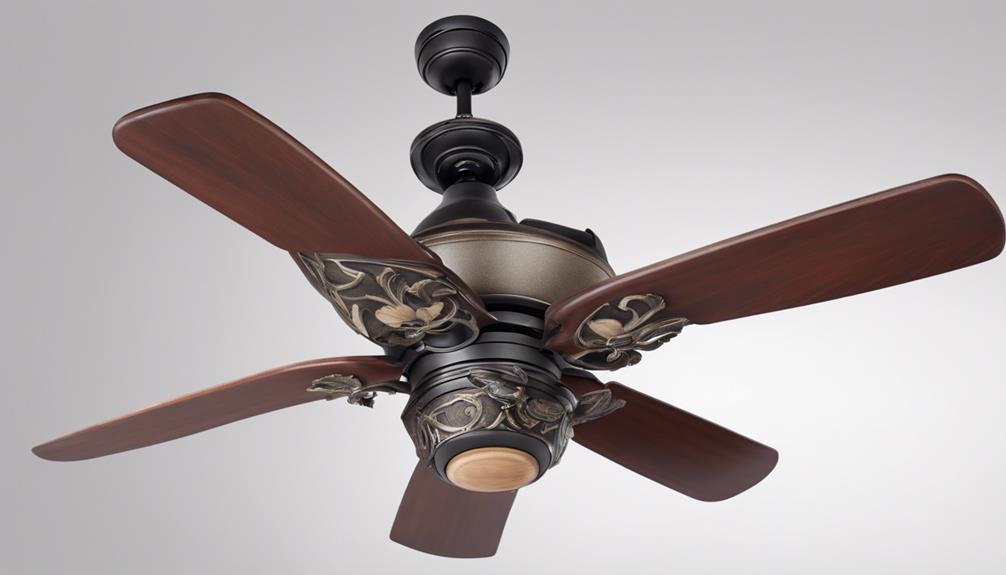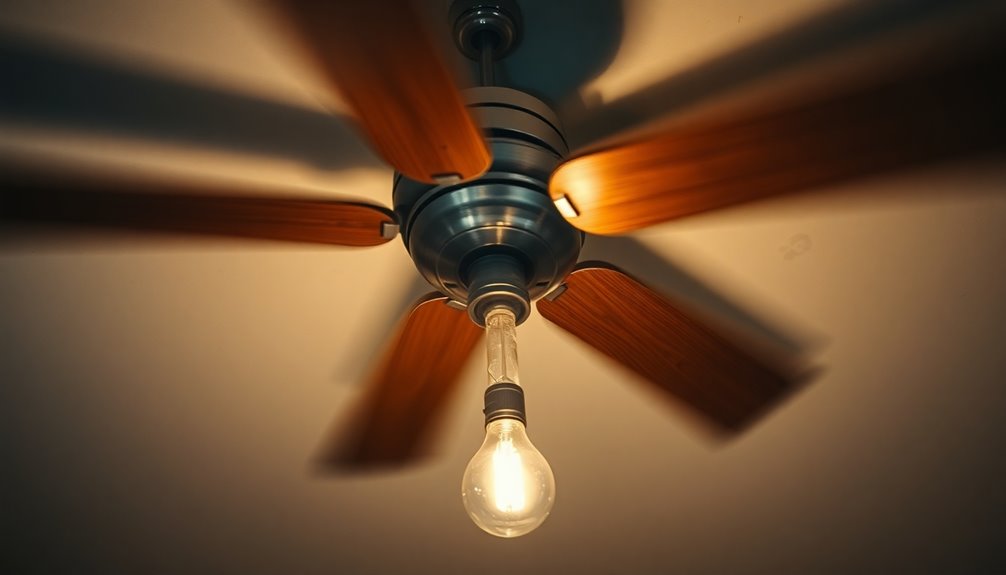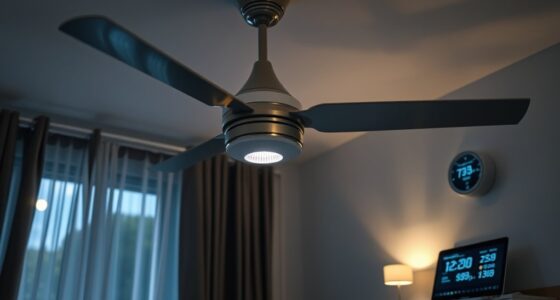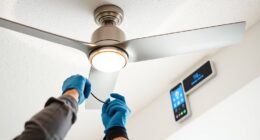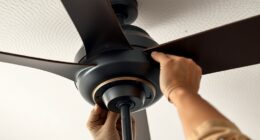US ceiling fans typically have 3 to 5 blades, while Indian fans usually feature 3 blades. The number of blades on US fans can vary, with some opting for 4 or 5 blades to enhance airflow and circulation. In contrast, Indian fans prioritize functionality, aiming for optimal airflow efficiency to provide a strong cooling effect. Factors like regional climate demands and design preferences influence the blade configuration, impacting air movement and power consumption. Understanding these distinctions can help homeowners choose the right fan for their needs, ensuring efficient airflow and cooling performance.
Key Takeaways
- US fans typically have 3 to 5 blades, while Indian fans usually have 3 blades for optimal airflow.
- US fans may opt for 4 or 5 blades for enhanced airflow and aesthetics.
- Indian fans prioritize functionality, with some high-speed models featuring 4 or 5 blades.
- US fans balance airflow and design, while Indian fans focus on airflow efficiency.
- Blade configuration is influenced by regional climate demands and design preferences in both countries.
Average Number of Blades on US Fans
On average, US ceiling fans typically feature 3 to 5 blades, with many opting for 4 or 5 blades for enhanced airflow and circulation. The number of blades on a ceiling fan can impact its performance and efficiency. More blades generally mean more air circulation, making the room feel cooler.
Some high-end US fans may have 3 blades for a sleek and modern look, catering to those who prioritize style. When choosing a fan, consider the room size and ceiling height to determine the optimal number of blades for efficient airflow.
Fans with more blades are designed to work well in conjunction with air conditioning systems, ensuring a comfortable environment. Whether you prefer a classic 4-blade design or a more contemporary 5-blade option, US ceiling fans offer a variety of choices to suit your aesthetic preferences and cooling needs.
Average Number of Blades on Indian Fans

When comparing the average number of blades on US ceiling fans to Indian fans, it can be observed that Indian ceiling fans typically feature 3 blades for optimal airflow and cooling efficiency. Indian fans are designed with functionality in mind, focusing on providing a strong cooling effect without necessarily lowering room temperature. The choice of three blades strikes a balance between airflow and power consumption, ensuring an effective cooling solution for the Indian climate.
While some high-speed Indian fans may have 4 or 5 blades to enhance airflow, the standard remains at 3 blades for most models. Unlike some US fans that prioritize decorative features like fancy lights, Indian fans concentrate on maximizing airflow to deliver a refreshing breeze. This emphasis on functionality over aesthetics showcases the practical approach Indian manufacturers take in designing ceiling fans tailored to the needs of Indian households.
Factors Influencing Blade Configuration
Factors influencing the configuration of blades in ceiling fans include regional climate demands and design preferences. In the US, where ceiling fans commonly have 3 to 5 blades, the focus is on balancing airflow and aesthetics. This is especially important in rooms with lower ceilings, where more blades help circulate air efficiently.
On the other hand, Indian fans typically feature 3 blades to maximize airflow for a cooling effect. The amount of air movement and power consumption are impacted by the number of blades, with American fans often designed to complement air conditioning systems. Indian fans prioritize airflow efficiency over decorative elements, reflecting the emphasis on cooling in warmer climates.
Understanding these factors can help homeowners choose the right fan for their needs, whether it's enhancing air circulation or maximizing cooling effectiveness. Ultimately, the design of ceiling fan blades plays a crucial role in determining the fan's performance in terms of airflow and comfort.
Impact of Blade Design on Airflow

Blade design significantly influences the airflow efficiency and cooling performance of ceiling fans. When considering the impact of blade design on airflow, it's essential to understand how it affects the overall effectiveness of the fan motor.
Here are three key points to consider:
- Blade Pitch: The angle of the blades plays a crucial role in determining how much air the fan can circulate. A steeper blade pitch can move more air but may require a more powerful fan motor to maintain efficiency.
- Blade Shape: The shape of the blades can also impact airflow. Curved blades are often more efficient at moving air compared to flat blades, as they can create better air circulation within a room.
- Blade Number: The number of blades on a fan can affect airflow and noise levels. While more blades can provide better air distribution, they may also create additional drag on the fan motor, potentially reducing overall efficiency.
Considering these factors can help you choose a ceiling fan with the right blade design for optimal airflow and cooling performance.
Comparison of Blade Designs and Efficiency
US ceiling fans typically feature 3 to 5 blades, emphasizing air conditioning support and decorative aspects. When comparing the blade designs and efficiency of US and Indian ceiling fans, it's essential to note the focus on airflow and cooling effects. Here's a breakdown of the key differences:
| Aspect | US Ceiling Fans | Indian Ceiling Fans |
|---|---|---|
| Blade Designs | Blades designed for efficiency and airflow support | Blades configured for maximum airflow and cooling |
| Efficiency | Emphasizes complementing air conditioning | Prioritizes higher airflow and cooling effect |
US fans are crafted to efficiently generate airflow and work in tandem with air conditioning systems, whereas Indian fans prioritize maximum airflow and evaporative cooling, ideal for hotter climates. By understanding these distinctions in blade designs and efficiency, consumers can choose the ceiling fan that best suits their needs and climate conditions.
Frequently Asked Questions
Why Do Indian Fans Have 3 Blades?
In Indian fans, the 3-blade design is specifically crafted to enhance air circulation and maximize cooling efficiency. This configuration optimizes airflow and power consumption, ensuring effective cooling without compromising room temperature.
The deliberate choice of 3 blades in Indian fans prioritizes functionality and efficiency over additional features like reverse rotation or fancy lights. The design is tailored to suit hot climates, providing a cooling effect that's essential for comfort in Indian households.
Why Do American Fans Have 5 Blades?
American fans typically have 5 blades for enhanced aesthetic appeal and energy efficiency. The additional blades not only look stylish but also help in distributing air more evenly, especially in rooms with lower ceilings.
This design choice balances functionality and decoration, making these fans popular in the U.S. The 5-blade configuration also contributes to better cooling efficiency, highlighting the focus on both design and performance in American ceiling fans.
What Is the Size of Ceiling Fan Blade in India?
In India, ceiling fan blades typically range from 1200mm to 1400mm in size. They commonly feature 3 blades to maximize efficiency and cooling effects.
The design prioritizes functionality over decorative aspects. The larger blade size aids in generating higher airflow for hot climates.
This emphasis on airflow and cooling efficiency sets Indian fans apart, showcasing a blend of practicality and design aesthetics tailored for optimal performance.
Does the Number of Blades on a Ceiling Fan Make a Difference?
Having the right number of blades on a ceiling fan can affect energy efficiency, aesthetics, air circulation, and noise levels. More blades may enhance airflow but could also increase noise and reduce efficiency.
Understanding these aspects can help in selecting a fan that suits your needs. It's crucial to strike a balance between blade count and performance to ensure optimal comfort and functionality in your living space.
What is the Standard Number of Blades for Ceiling Fans in Different Countries?
In the United States, the standard ceiling fan blade count is generally four or five. However, in countries like India and Australia, the standard number of ceiling fan blades is often three. The blade count can affect the fan’s performance and air circulation, so it’s important to consider when purchasing a ceiling fan.
Conclusion
In conclusion, when it comes to the number of blades on ceiling fans, the US tends to have more blades than Indian fans.
This difference in design can impact airflow and efficiency.
So, next time you're shopping for a fan, consider the number of blades and how it might affect the cool breeze in your home.
Happy fan hunting!

